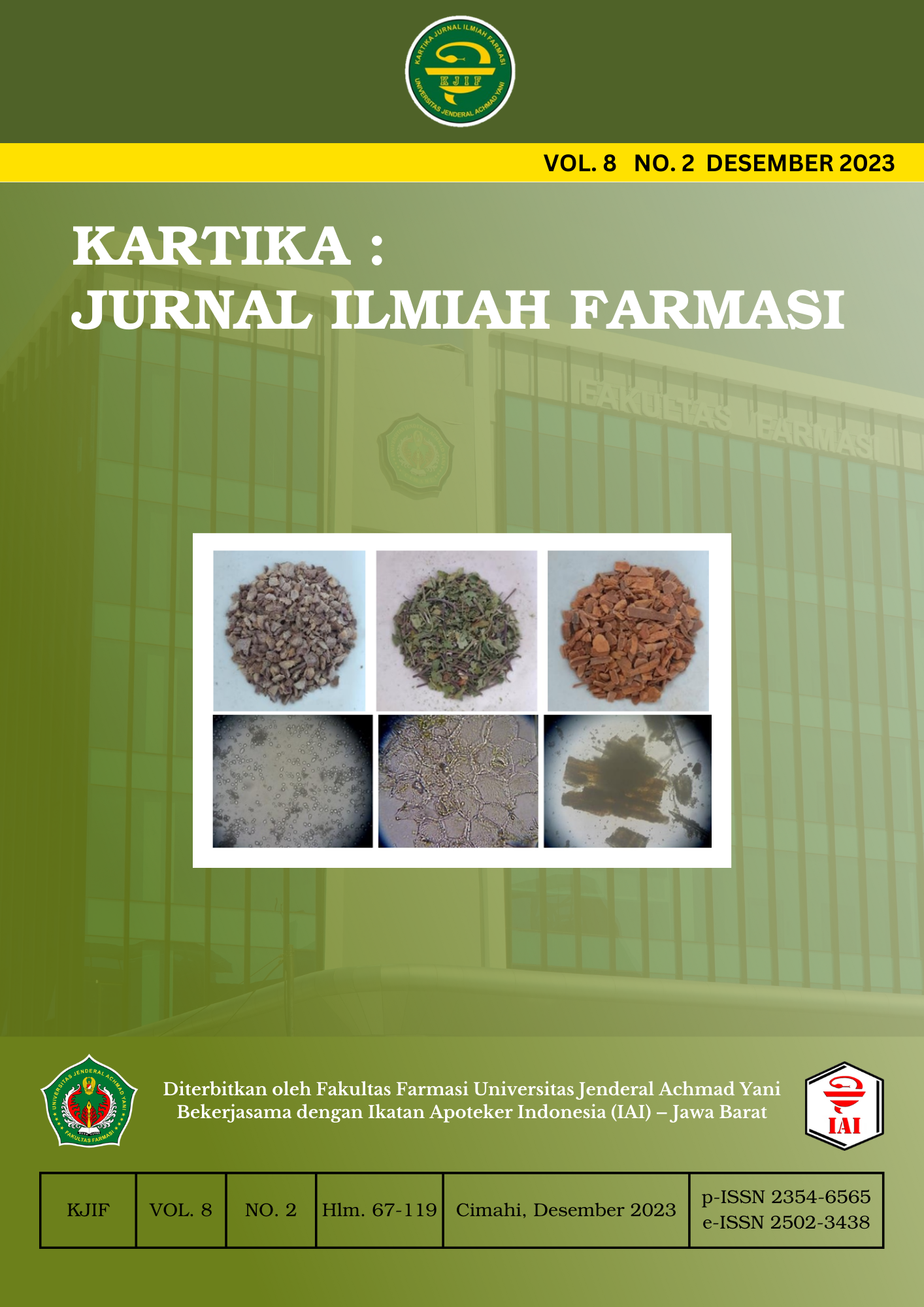POTENSI EKSTRAK JAHE MERAH (Zingiber officinale Roscoe var. sunti), PEGAGAN (Centella asiatica (L.) Urb.) DAN KAYU MANIS (Cinnamomum Burmanni (C.Ness & T.Ness)) SEBAGAI HERBAL PENUNDA KEPIKUNAN
DOI:
https://doi.org/10.26874/kjif.v8i2.650Abstrak
Demensia atau kepikunan merupakan sindrom yang disebabkan oleh gangguan di otak. Sebanyak 60-70% demensia disebabkan oleh penyakit alzheimer. Penyakit alzheimer disebabkan oleh adanya penurunan asetilkolin (ACh) karena dihidrolisis oleh enzim asetilkolinesterase (AChE). Penghambatan aktivitas enzim AChE digunakan sebagai terapi penyakit alzheimer. Tanaman herbal memiliki potensi untuk menghambat enzim asetilkolinesterase karena memiliki banyak kandungan kimia. Tujuan dari penelitian ini adalah menentukan aktivitas peghambatan enzim AChE dari 3 jenis tumbuhan yang ada di Indonesia yaitu jahe merah (Zingiber officinale Roscoe var. sunti), pegagan (Centella asiatica (L.) Urb.), dan kayu manis (Cinnamomum burmanni (C.Ness & T.Ness)) serta kombinasi masing-masing ekstrak. Proses ekstraksi simplisia menggunakan metode maserasi dalam etanol 96%. Pengujian aktivitas penghambat asetilkolinesterase (AChE) menggunakan metode Ellman. Hasil penelitian menunjukkan ekstrak etanol herba pegagan, dan kulit kayu manis berturut-turut sebesar 818,011 ug/mL dan 186,737 ug/mL, sedangkan ekstrak etanol jahe merah memiliki nilai IC50> 1000 ug/mL. Nilai IC50 zat aktif donepezil adalah 0,277 ug/mL. Ekstrak etanol kulit kayu manis menunjukkan aktivitas penghambatan enzim AChE paling baik. Kombinasi ekstrak rimpang jahe merah dan kulit kayu manis dengan nilai IC50 293,166 ug/mL lebih lemah dari ekstrak tunggalnya, diduga sifat kombinasi kedua ekstrak tersebut antagonis. Ekstrak etanol kulit kayu manis paling berpotensi untuk dikembangkan lebih lanjut sebagai herbal penunda kepikunan.
Kata kunci : Kepikunan, jahe merah, pegagan, kayu manis.
Abstract
Dementia is a syndrome caused by a variety of brain disorder. About 60-70% dementia is caused by alzheimer disease. Decrease in acetylcholine level led by the hydrolysis of acetylcholinesterase enzym (AChE) has been the common cause of Alzheimer disease. Inhibitory activity of AChE enzyme is used in the alzheimer disease therapy. Herbal plants have the potential as the AChE inhibitor because it contains a lot of chemical compounds. This study aims at studying the inhibitory activity of acetylcholinesterase enzyme of three plants existing in Indonesia, namely Red Ginger (Zingiber officinale Roscoe var. sunti), Gotu Kola (Centella asiatica (L.) Urb.) and Cinnamon (Cinnamomum burmanni (C.Ness & T.Ness)) as well as the combination of their respective extracts. Simplicia was extracted with maceration method using ethanol 96%. AChE inhibitory activity was tested using Ellman method. The results show that IC50 value of ethanolic extracts of Gotu Kola and Cinnamon herbs are 818.011 ug/mL and 186.737 ug/mL respectively, while for red ginger is > 1000 ug/mL. The IC50 value of donepezil active substance is 0.277 ug/mL. Ethanolic extract of Cinnamon was found to have the best inhibitory activity of AChE enzyme. Combined extracts of red ginger and cinnamon with the IC50 value of 293.166 ug/mL has been the most effective inhibitor of AChE enzyme. Cinnamon ethanolic extract has the greatest potential for further development in the herbal extracts for dementia prevention.
Keywords : dementia, red ginger, gotu kola, cinnamon.
Referensi
Balkis, A., Tran, K., Lee, Y. Z., & Ng, K., 2015. Screening Flavonoids for Inhibition of Acetylcholinesterase Identified Baicalein as the Most Potent Inhibitor. Journal of Agricultural Science, 7(9), 26-35.
Borgert, C. J., Borgert, S. A., & Findley, K. C., 2005. Synergism, antagonism, or additivity of dietary supplements: Application of theory to case studies. Thrombosis Research, 117(1-2), 123-132.
Bui, T. T., & Nguyen, T. H., 2017. Natural product for the treatment of Alzheimer's disease. Journal of Basic and Clinical Physiology and Pharmacology, 28(5), 413-423.
Che, C. T., Wang, Z. J., Chow, M. S. S., & Lam, C. W. K. (2013). Herb-herb combination for therapeutic enhancement and advancement: Theory, practice and future perspectives. Molecules, 18(5), 5125-5141.
Departemen Kesehatan Republik Indonesia, 2008. Farmakope Hebal Indonesia.
Dos Santos, T. C., Gomes, T. M., Pinto, B. A. S., Camara, A. L., & De Andrade Paes, A. M., 2018. Naturally occurring acetylcholinesterase inhibitors and their potential use for Alzheimer's disease therapy. Frontiers in Pharmacology, 9(OCT), 1-14.
Estevam Ribeiro, P. R., De Carvalho Neto, M. F., Chagas, E. A., Chagas, P. C., Takahashi, J. A., De Melo, A. C. G. R., De Melo Filho, A. A., 2019. Acetylcholinesterase inhibitory potential in cinnamon seed oil (cinnamomum zeylanicum nees) lauraceae from Roraima, Brazil. Chemical Engineering Transactions, 75(March), 361-366.
Gunawan, S. G., Setiabudy, R., Nafrialdi, & Elysabeth., 2007. Farmakologi dan Terapi, Edisi. Jakarta: Departemen Farmakologi dan Terapeutik, FKUI.
Gustri, L., 2019. Hubungan Asupan Zat Gizi dengan Kejadian Demensia. Journal of Nutrition and Health, 7(2), 39-42.
Jung, M., & Park, M., 2007. Acetylcholinesterase inhibition by flavonoids from Agrimonia pilosa. Molecules, 12(9), 2130-2139.
Khan, H., Marya, Amin, S., Kamal, M. A., & Patel, S., 2018. Flavonoids as acetylcholinesterase inhibitors: Current therapeutic standing and future prospects. Biomedicine and Pharmacotherapy, 101 (October 2017), 860-870.
Liesener, A., Perchuc, A. M., Schoni, R., Schebb, N. H., Wilmer, M., & Karst, U., 2007. Screening of acetylcholinesterase inhibitors in snake venom by electrospray mass spectrometry. Pure and Applied Chemistry, 79(12), 2339-2349.
Mukherjee, P. K., Kumar, V., & Houghton, P. J., 2007. Screening of Indian Medicinal Plants for Acetylcholinesterase Inhibitory Activity. Phytother Res, 21(12), 1142-1145.
Natarajan, S., Shunmugiah, K. P., & Kasi, P. D., 2013. Plants traditionally used in age-related brain disorders (dementia): An ethanopharmacological survey. Pharmaceutical Biology, 51(4), 492-523.
Nuria, M. C., Sukandar, E. Y., Suganda, A. G., & Insanu, M., 2019. Aktivitas Inhibisi Asetilkolinesterase Empat Jenis Sayuran Secara in Vitro. JIFFK: Jurnal Ilmu Farmasi Dan Farmasi Klinik, 16(01), 43.
Oboh, G., Ademiluyi, A., & Akinyemi, A., 2012. Inhibition of
Acetylcholinesterase Activities and Some Pro-Oxidant Induced Lipid Peroxidation in Rat Brain by Two Varieties of Ginger (Zingiber officinale). National Center of Biologycal Information.
Owokotomo, I. A., Ekundayo, O., Abayomi, T. G., & Chukwuka, A. V., 2015. In-vitro anti-cholinesterase activity of essential oil from four tropical medicinal plants. Toxicology Reports, 2, 850-857.
Sharma, K., 2019. Cholinesterase inhibitors as Alzheimer's therapeutics (Review). 1479-1487.
WHO. 2012. Dementia, a public health priority.
Wiesner, J., Kriz, Z., Kuca, K., Jun, D., & Koca, J., 2007. Acetylcholinesterases - The structural similarities and differences. Journal of Enzyme Inhibition and Medicinal Chemistry, 22(4), 417-424.
Zhou, X., Seto, S. W., Chang, D., Kiat, H., Razmovski-Naumovski, V., Chan, K., & Bensoussan, A., 2016. Synergistic effects of Chinese herbal medicine: A comprehensive review of methodology and current research. Frontiers in Pharmacology, 7, 1-16
##submission.downloads##
Diterbitkan
Cara Mengutip
Terbitan
Bagian
Lisensi
Hak Cipta (c) 2023 Kartika : Jurnal Ilmiah Farmasi

Artikel ini berlisensi Creative Commons Attribution 4.0 International License.
Penulis yang menerbitkan artikel pada jurnal ini menyetujui ketentuan berikut:
- Penulis memberikan hak cipta dan jaminan atas artikel sebagai publikasi pertama, yang memberikan kesempatan pada orang lain untuk membagi artikel dibawah lisensi Creative Commons Attribution License
- Penulis dapat melakukan perubahan dan menambahkan untuk pendistribusian artikel yang terpublikasi secara non eksklusif (misalnya, mempostingnya ke repositori institusional atau mempublikasikannya dalam sebuah buku), dengan pengakuan publikasi awal dalam jurnal ini.
- Penulis diizinkan dan didorong untuk memposting pekerjaan mereka secara online (misalnya, di repositori institusional atau di situs web mereka) sebelum dan selama proses pengajuan, karena dapat mengarah pada pertukaran produktif, serta kutipan pekerjaan sebelumnya dan lebih besar yang diterbitkan (Lihat The Effect of Open Access).























